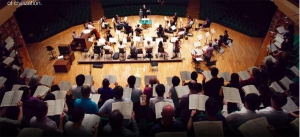Ludwig van Beethoven’s Symphony No.9 is one of the most famous symphonies in the western music history. This time “The Hong Kong Bach Choir” presented the large-scale symphony No.9 in Cultural Centre to the audience.
The concert was divided into two sections and it started with an orchestral composition Choros No. 10, W209 “Rasga o curacao” written by a Brazilian composer, Heitor Villa-Lobos, and completed in 1926. Choros No. 10 regarded as Brazil’s answer to Beethoven 9th symphony, which is an interesting choice as an introduction of the concert. Choros is used as the name of music played by an ensemble of Brazilian street musicians, and it is also widely adopted in the series of compositions by Villa-Lobos. Choros No. 10 started with short phrase by flute to create a contrast of the beginning by presenting a light texture to audience. Flute subsequently was used to imitate the call of Blue-Black Grosbeak, whereas clarinet imitated echo throughout the piece. Choral entry appeared in the later half of the piece and gradually developed an unstoppable dancing momentum until the end.
Overall this pieces present joyful and carnival mood. It was an interesting alternative to introduce the highlight of the concert. In normal classical concert, Villa-Lobos is not a common choice when selecting twentieth century compositions as he is relatively less popular and well known for general public. Therefore, this programming, which is also the first performance by The Hong Kong Bach Choir & Orchestra, was an innovative yet very wise in the concept of programming. It is because putting it together with Beethoven’s 9th symphony can provide a chance to introduce great variety of serious music around the global. However, though the concept is good, the programme planning can be better in terms of time management. The duration of Choros No.10 was around 12 minutes only, but then it followd by a 15minutes interval afterwards. Although it is reasonable for putting an interval before the one-hour-long symphomy, this unexpected break still inevitably cause little distraction rather than serving the purpose of refreshing audience.
The second half of the concert was the highlight of concert. Ludwig van Beethoven’s symphony No.9 in D minor Choral is the most ambitious work in a series of pieces that changed forever the concept of the symphony (Levy, 1995). Whole piece, which is over one hour, was completed in 1824 and it was the first example of major composer who wrote a symphony included vocal element. In his final completed symphony, it shows the thrill of Ode to Joy last movement and the power of symphony.
In the first performance of the symphony by Hong Kong Bach Choir, however, was a little bit disappointed of their interpretation. The two major concerns of the performance were the organization of orchestra and the use of space of voice projection. Firstly, the first movement was the essential part to give what kind of impression to audience. The characteristics of first movement are powerful and concentrate, and that is the reason why this symphony is so demanding in terms of the quantity of musicians and ability of soloists. The instrument arrangement in this concert maybe limited by scale of the Bach Choir and therefore cannot reach the ideal number of musicians needed to fully present the symphony. Lack of musicians in violin section was quite obvious and it could explain the imbalance sound projection of the whole orchestra. In the general practice of a professional orchestra under normal circumstances, first violin section will be placed at the left hand side closest to conductor, whereas second violin will be placed at opposite side. Nonetheless, given that there were insufficient number of violin players in the performance, but the first and second violin still follow the routine and separated. Thus the organization as a result magnified the problem of the insufficiency of violins. In addition, there were four double bass used in the band. Despite they successfully enriched the texture of the symphony, this organization also weakened the clarity of violin section and worsening problem of imbalanced sound.
Apart from the concern in string section, the setting of percussion was unusual in the concert as well. Timpani individually placed out of the percussion section. One of the possible reasons for this unusual organization would be the limitation of the venue. Symphony No.9 was written in a large-scale orchestration with choral section thus wider space is needed for organizing all musicians in an attempt to maximize the power and effect of this composition. However, under limitations such as size of venue and insufficient of players, Bach Choir’s interpretation was lack of power and concentration regrettably. The sound was not strong enough to project to every corner of the hall.
The fourth movement was the most challenging one. It started with Presto and continues to accelerate until the end Prestissimo. All voices and full orchestra pushed the atmosphere and volume to the limit to show the appreciation of god in this movement. Bach Choir created a tension within this movement but the tension was not powerful enough to maximize the climax of it. The choir were arranged to perform at the balcony, but not the stage. Although there were quite a number of singers, distance between choir and audience were too far that their voices almost covered by other instruments.
Overall there was a strong linkage between Hong Kong Bach Choir and the programmes they selected. Beethoven first introduced choral into a symphony, whereas Bach Choir first challenged this composition. The concept behind is very meaningful. If the venue, organization and choice of programme can be further developed, it is very likely to become an overwhelming and remarkable concert for audience.



